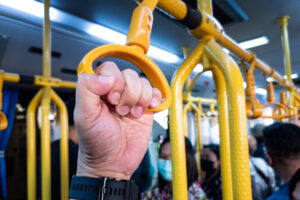
The key to using AI technologies in public transit is onboard internet connectivity, which facilitates real-time data transfer and enables seamless communication both within the vehicle and to and from the cloud.
When people talk about the impact of artificial intelligence, they’re more likely to be talking about chatbots and copilots than coaches and trains. But AI is already having a transformative effect on public transit and how we travel today.
At times, the public transportation sector lagged behind in technological innovation, often taking years to recognize issues, determine solutions, and implement changes. Now, machine learning systems are revolutionizing the industry, processing vast datasets in real time to predict outcomes, spot irregularities, and swiftly arrive at effective solutions to complex problems.
This technological leap is enabling public transit systems to adapt intelligently to individual preferences and real-time demands, heralding a new era of dynamic and responsive transportation.
See also: How IoT in Transportation Makes Big Data Valuable For Businesses
How AI is injecting boundless opportunities into public transit
AI is helping operators to deliver smarter, safer journeys. A prime example is “Project Luna,” a transport accessibility solution by Arriva Rail London. Providing accessible information to all passengers, especially those who are deaf or hard of hearing, has long been a challenge for transit operators. Arriva Rail London is addressing this issue with Luna, an AI-powered solution developed by GoMedia for use on the London Overground network.
Project Luna uses artificial intelligence to translate digital information into British Sign Language (BSL), delivering it directly to passengers’ smart devices through personalized digital signers. The system provides real-time updates on station information, live departures, and service disruptions, ensuring that BSL users have equal access to crucial travel information.
This AI-driven solution significantly improves the travel experience for deaf and hard-of-hearing passengers, allowing them to navigate the network more independently and confidently. By leveraging AI to break down communication barriers, Project Luna demonstrates how technology can make public transportation more inclusive and accessible for all users.
How AI assists in passenger counting
Every transit operator wants to count passengers, but that’s a difficult task when multiple conductors are stepping on and off a train several times over a two-hour run. Northern — the second largest train operator in the UK with 2,500 services a day across the North of England — has started using AI to count the number of passengers on some of its services.
The train operator has deployed an automatic passenger counting (APC) algorithm — which tests show is over 98% accurate — to software on its fleet of eight Class 769 trains. A team of 15 specialist engineers installed 88 cameras and eight computers using five kilometers of cables. The internal and externally mounted cameras on each train capture video footage in high definition — even in low-light and high-contrast environments. AI technology analyzes the anonymized video.
This algorithm’s accuracy and speed of processing supports Northern in managing fleet and staff capacity. The ability to effectively gauge occupancy levels can also make it easier for passengers to choose less noisy or crowded environments to travel in, ensuring that they are comfortable throughout their journey. The onboard digital video network has proven more effective than traditional sensor-based systems while also reducing the time and costs needed to install and maintain separate pieces of hardware and disparate backend systems.
Why connectivity is central to AI in transportation
Transport operators are leveraging machine learning to detect anomalies with connectivity, hardware, and software and then raise automated alerts. Operators are also using deep learning, which incorporates neural networks with multiple layers — inspired by the structure and function of the human brain — to solve complex tasks. The technology’s ability to recognize specific objects, actions, or scenarios in live video surveillance feeds enables operators to proactively monitor for issues more efficiently than traditional forensic-based surveillance tools.
The backbone of these AI technologies in public transit is onboard internet connectivity, which facilitates real-time data transfer and enables seamless communication both within the vehicle and to and from the cloud.
Edge computing allows the data generated on a vehicle to be processed locally, close to the source, rather than sending the data offboard to be processed. Edge computing enhances security and data privacy and is especially useful for video data processing, which would require a lot of costly bandwidth to offload. Locating computing power on the vehicle effectively turns a train into a rolling data center.
AI reaps the benefits from both the onboard connectivity and edge computing by gaining faster access to the processed data, which means real-time analytics and decision-making can take place. With onboard internet connectivity, operators can select between edge and cloud computing for each specific use case. Rail operators need a strong connectivity backbone to support these real-time analytics and insights.
As AI is constantly evolving, forward-thinking transit operators are embracing the technology to perform daily operations better.





























